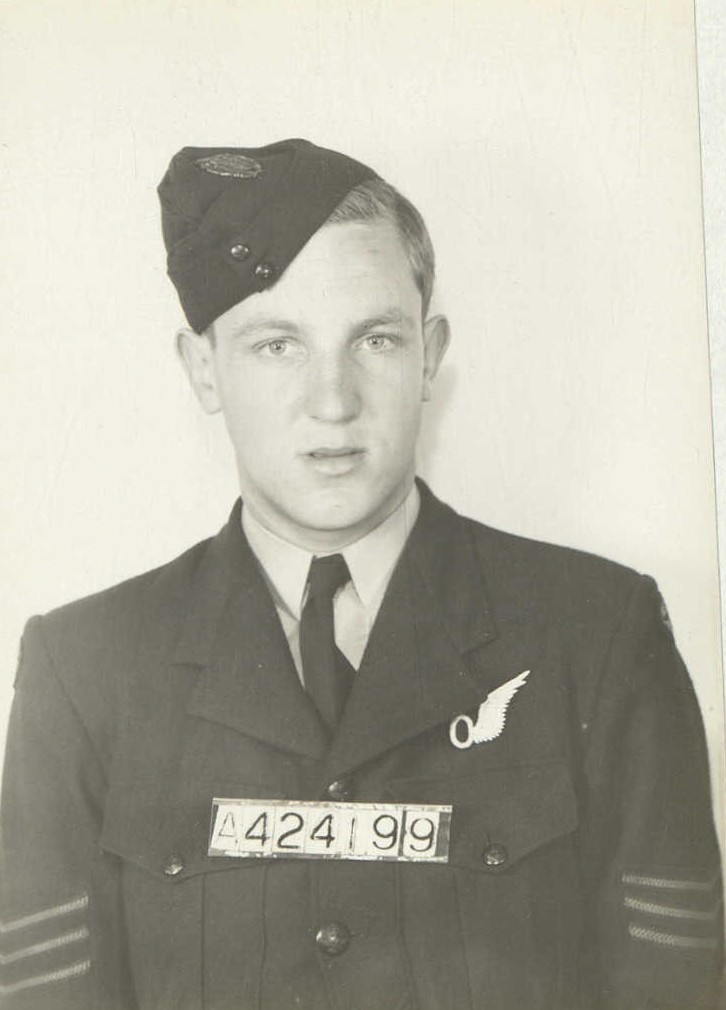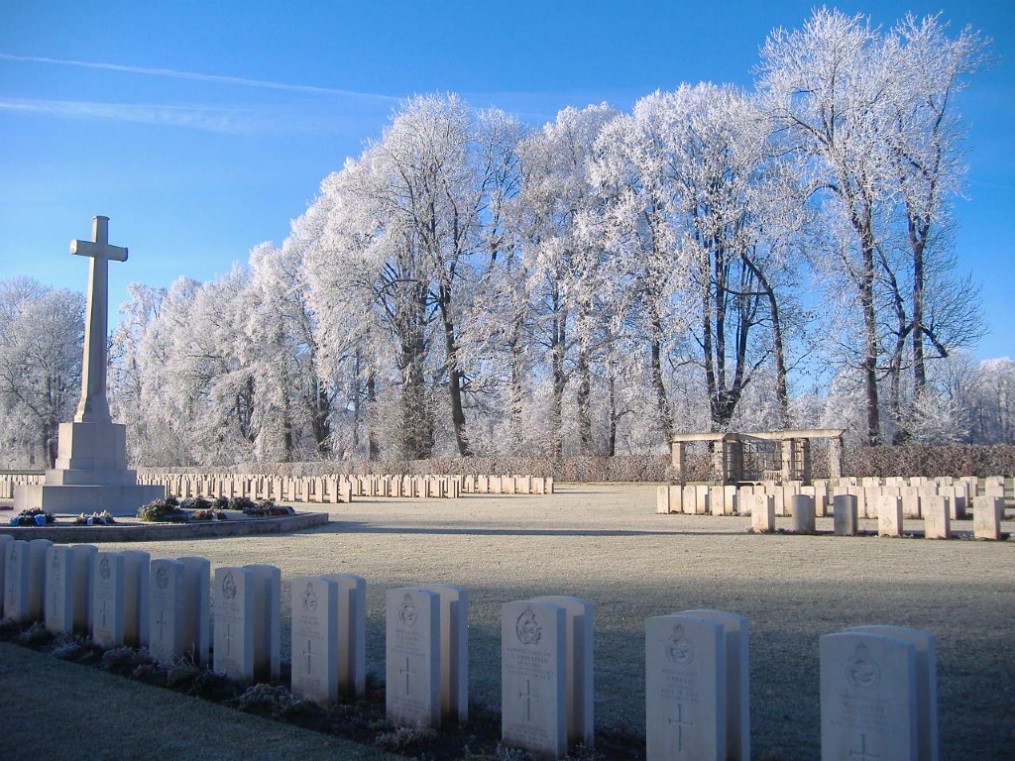Warrant Officer Neil MacDonald Menzies, the son of Stewart MacDonald and Catherine McLean MacDonald Menzies, was born at Glen Innes in New South Wales on 15th June 1924. He was educated at the New England Grammar School at Glen Innes in New South Wales during the years 1931 until 1938. He then attended the Toowoomba Grammar School during the years 1939 until 1940 where he passed the Queensland University Senior Public Examination. Whilst a student at the Toowoomba Grammar School he was a member of the Cadet Corps. He also served in the Air Training Corps for 4 months where he learned Morse Code. After leaving school he was employed as a Jackeroo at a north-western station for 10 months before working as a Junior Clerk with A.M.L. & F. Company Limited. He applied for aircrew training in the Royal Australian Air Force on 14th May 1942.
Warrant Officer Neil Menzies was enrolled in the Reserve of the R.A.A.F. in Sydney on 29th June 1942 after swearing an oath of allegiance. At the age of 18 years and 2 months he was enlisted into the Citizen Air Force of the R.A.A.F. at No. 2 Recruiting Centre in Sydney on 15th August 1942 after giving an undertaking that he would serve for the duration of the war and an additional twelve months. His physical description at the time of his enlistment was that he was 6 feet 2 inches in height and weighed 152 pounds. He had a fair complexion, blue eyes and brown hair. He stated that he was of the Church of England religion. He gave his next of kin as his father, Major S.M. Menzies, c/- Imperial Service Club, Barrack Street, Sydney, New South Wales. His father’s address was later changed to Moore Park, Armidale, New South Wales.
Warrant Officer Neil Menzies was allotted the service number of 424199. He joined No. 2 Initial Training School at Lindfield in New South Wales on 15th August 1942. He joined No. 1 Air Observer School at Cootamundra in New South Wales on 10th December 1942. He joined No. 3 Bombing & Gunnery School at Sale in Victoria on 8th March 1943. He qualified for the Air Observer’s Qualification Badge on 29th April 1943. He joined No. 2 Air Navigation School at Nhill in Victoria on 3rd May 1943. He was awarded the Air Navigator Qualification Badge and promoted to the rank of Temporary Sergeant on 27th May 1943. He joined No. 2 Embarkation Depot at Bradfield Park in New South Wales on 28th May 1943 to prepare for movement overseas on attachment to the Royal Canadian Air Force for further training. He embarked at Brisbane in Queensland on 6th July 1943 and he disembarked in Canada on 25th July 1943 and later that day he joined No. 3 Manning Depot at Edmonton, Alberta. Warrant Officer Neil Menzies joined No. 1 General Reconnaissance School at Royal Canadian Air Force Station Summerside on 2nd September 1943 where he trained in navigation for four weeks.
Warrant Officer Neil Menzies embarked from Halifax in Nova Scotia on 1st November 1943 for movement to England on attachment to the Royal Air Force. He joined No. 11 Personnel Despatch & Reception Centre in England on 10th November 1943. He was promoted to the rank of Temporary Flight Sergeant on 27th November 1943. He joined No. 1 (Observer) Advanced Flying Unit at Royal Air Force Station Wigtown on 21st March 1944. He joined No. 27 Operational Training Unit at Royal Air Force Station Lichfield on 25th April 1944. He joined the Battle School at No. 51 Base Royal Air Force Station Scampton on 12th July 1944. He joined No. 106 Squadron at Royal Air Force Station Cottesmore for operational duty on 30th July 1944. He was promoted to the rank of Temporary Warrant Officer on 27th November 1944.
Warrant Officer Neil Menzies was the Navigator and crew member of a No. 106 Squadron Royal Air Force Lancaster PB 281 that was lost during air operations in Germany on 4th December 1944. The aircraft left its base at 1630 hours to attack an enemy target at Heilbronn in Germany.
The Commanding Officer of No. 106 Squadron wrote the following letter to his mother on 6th December 1944:
I am writing to express my sympathy in the anxiety which must be yours upon receipt of the news that your son, Flight Sergeant (sic) Neil Menzies, is missing from an operational flight. I shall also give you such details as I am able and which could not be embodied in the necessarily brief and impersonal telegram. On the night of 4/5th December 1944 your son was the Navigator of an aircraft taking part in an attack on the important railway yards at Heilbronn, near Karlsruhe. The raid was successful but I regret that your son’s aircraft did not return. Nothing was heard after the take-off and there is no definite knowledge of what happened, but it must be assumed that the aircraft was a victim of either ground defences or fighters. In either event, however, there is a possibility that the crew bailed out and that, although prisoners of war, are quite safe. We all hope that his is indeed the case, and you may be sure that the Red Cross will spare no effort to obtain information for you. Your son had taken part in six operational sorties during the few weeks he had been with my squadron. He was a very able Navigator and much of the success of his crew was due to his skilful navigation. We are appreciative of the motives which brought him from Australia to help us, and I can assure he will not soon be forgotten. Once again, both personally and on behalf of all the squadron, I offer my deepest sympathy and hope that soon there will be good news. Yours Sincerely, M.M.J. Stevens.
The fate of the Lancaster and its crew became known after the end of the war when Warrant Officer Burton, a member of the crew, who survived the crash and became a prisoner of war reported that the aircraft iced up, went out of control and crashed with the full crew between Stuttgart and Heilbronn. He further stated that the aircraft burned and that he found two bodies which he could not identify.
The French Intelligence Division Detachment in the French zone of Germany provided the following report on 1st August 1946:
In January 1945 a British four-motored bomber (Halifax or Lancaster) crashed in the Black Forest about 10 kilometres from Wildbad at a spot called Wildsee. Five bodies were removed from the wreckage by Germans and given burial in the cemetery at Wildbad as “Unknown British Airmen” – these remains were so burnt that no means of identification remained. No official report seems to have been made on this incident, and the first intimation came this week through German sources to the French Air Security, who are now examining the wreckage. It was also reported that further human remains were still lying near the plane, which may be those of a sixth member of the crew. If on examination this proves to be the case, the Commanding Officer of the French Air Security will undertake that fitting burial is made in the Wildbad Cemetery.
After the war No. 2 Missing Research & Enquiry Unit conducted an investigation into the fate of the aircraft and its crew and provided the following report on 16th May 1947:
Result of investigation and findings – On 9th May 1947 I went to a place called Wildsee and examined the wreckage of Lancaster PB.281 and found that no human remains were evident in the wreck but as this is a very bad crash it is very possible that an odd piece or two of human remains may still be amongst the wreckage. On questioning the Landrat in Wildbad I found that the remains of six men are buried in five coffins in Wildbad Cemetery on the road of Galmbach and that the other member, the tail gunner, was taken out of the aircraft alive and became a prisoner-of-war. This aircraft is lying in the middle of a vast swamp and some parts of the wreckage are already partly submerged. The grave is in the military section of the cemetery on the left hand side and is very obvious. The airmen were given a full military funeral by the French Air Force and the grave is very well kept.
The bodies in the communal grave were exhumed in an attempt to identify them individually with the help of dental charts. As a result of the exhumations it was only possible to identify Flight Sergeant Hanscombe of the R.A.A.F. and Sergeant Sands of the R.A.F. The bodies of Warrant Officer Menzies and three other crew members were re-interred in a communal grave in the Bad Tolz (Durnbach) British Military Cemetery.
At the time of his death Neil MacDonald was 20 years of age. His headstone in the Durnbach War Cemetery contains the family inscription “Greater Love Hath No Man Than This, That He Lay Down His Life”. For his service during World War 2, Neil Menzies was awarded the Air Observer Qualification Badge, the 1939/1945 Star, the France & Germany Star, the Defence Medal, the War Medal and the Australian Service Medal 1939/1945. His name is commemorated on Panel No. 127 at the Australian War Memorial in Canberra and locally on the Toowoomba Grammar School World War 2 Honour Board.
Toowoomba Grammar School archive records show that he enrolled as a student on 31st January 1939 and left the school on 29th November 1940.




